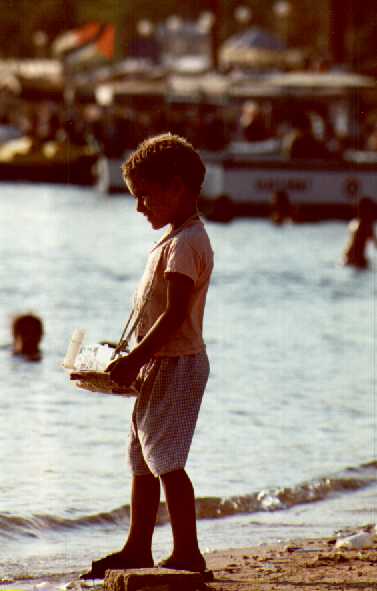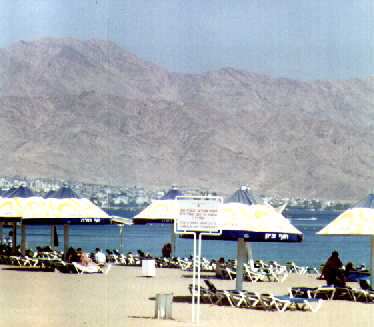Aqaba, Jordan
|
Aqaba, Jordan |
|

Aqaba, Jordan |

Eilat, Israel |
Eilat and Aqaba lie at the northern end of the Gulf of Aqaba at the extreme north end of the Red Sea. The two port cities function like identical twins. Eilat is Israel's only direct access to the Indian Ocean, but Aqaba is even more critical to Jordan as its only sea port of any kind.
In addition to the port facilities, Eilat and Aqaba are a cross-roads of a different kind. Two other countries also meet at this point. 11 km down the coast from Eilat is Taba, Egypt (where Israelis go to legally gamble). 15 km south of Aqaba is Saudi Arabia.
 This
natural location for a port has been inhabited even before the Israelite
conquest of the Holy Land and many archeological remains can be found on
the Aqaba side. King Solomon operated a port here called Ezion-Geber which
he used for trading with Egypt, Ethiopia and other places. The port was
excellently located for exporting the copper excavated in the mines of
Timna several kilometers to the north. The Romans, Nabateans, and Crusaders
all made use of the region.
This
natural location for a port has been inhabited even before the Israelite
conquest of the Holy Land and many archeological remains can be found on
the Aqaba side. King Solomon operated a port here called Ezion-Geber which
he used for trading with Egypt, Ethiopia and other places. The port was
excellently located for exporting the copper excavated in the mines of
Timna several kilometers to the north. The Romans, Nabateans, and Crusaders
all made use of the region.
In the 16th century the entire region fell under the Ottoman Turks until March 11, 1917 when British officer T.E. Lawrence led a daring group of Arab soldiers through the Saudi Arabian desert to conquer Aqaba and allow British ships to supply ships to get through.
 While
both Eilat and and Aqaba are invaluable to Israel and Jordan today, both
almost failed to become part of their countries. The Saudi Arabian-Jordanian
border was not clearly defined and Aqaba was in dispute until 1965 when
Jordan's King Hussein engineered a deal to part with a vast quantity of
desert in the southeast for Aqaba and 15 precious kilometers of coastline.
While
both Eilat and and Aqaba are invaluable to Israel and Jordan today, both
almost failed to become part of their countries. The Saudi Arabian-Jordanian
border was not clearly defined and Aqaba was in dispute until 1965 when
Jordan's King Hussein engineered a deal to part with a vast quantity of
desert in the southeast for Aqaba and 15 precious kilometers of coastline.
Israel's acquisition of Eilat was almost an afterthought. The State was nearly a year old and Israel's War of Independence was almost over when a bright officer of the Israeli defense force sent an expedition into to the village of Um Rashrash on May 8, 1949. The village was secured without firing a shot and became the foundation of what would become Eilat.
 For
the
next 45 years as Israel and Jordan maintained an official state of war,
both cities appeared to coldly glare at each other, so close yet so far
away. Ships bound for one port or the other would carefully stay on the
correct side of the gulf. An even more difficult task was given to the
pilots who needed to carefully observe each of the four countries' air
space and bring their planes into the microscopic amount of flat land in
the valley available for landing. One of the first of many cooperative
projects agreed on between Israel and Jordan after the signing of the 1994
peace treaty was to build a proper airport with shared runways and dual
terminals for both cities.
For
the
next 45 years as Israel and Jordan maintained an official state of war,
both cities appeared to coldly glare at each other, so close yet so far
away. Ships bound for one port or the other would carefully stay on the
correct side of the gulf. An even more difficult task was given to the
pilots who needed to carefully observe each of the four countries' air
space and bring their planes into the microscopic amount of flat land in
the valley available for landing. One of the first of many cooperative
projects agreed on between Israel and Jordan after the signing of the 1994
peace treaty was to build a proper airport with shared runways and dual
terminals for both cities.
In addition to being a vital port where many imports and exports arrive and depart, Eilat and Aqaba function as a recreational heaven. Both Eilat and Aqaba are separated from the population centers of their countries by vast stretches of desert. Therefore they have become something of a vacation retreat where rich buy vacation homes, and morals in general are much more relaxed than up north. Israel has made Eilat a duty free port and many Jordanians feel free to relax the discipline of devout Muslim dress so strictly followed in Amman. Large stretches of beach are available for sun-worshipers and nearly every hotel chain in the world has a franchise here.
 But
the most beautiful things to see in Eilat and Aqaba are under the water.
With the extremely warm climate and the warm waters coming from even warmer
regions to the south, Eilat and Aqaba boast the world's most northern coral
reefs. A veritable explosion of undersea fish and plant life can be discovered
either by snorkeling in the state parks, taking a tour in a glass bottom
boat or submarine, or by scuba diving the reefs or one of the ships that
have been deliberately sunk just off shore.
But
the most beautiful things to see in Eilat and Aqaba are under the water.
With the extremely warm climate and the warm waters coming from even warmer
regions to the south, Eilat and Aqaba boast the world's most northern coral
reefs. A veritable explosion of undersea fish and plant life can be discovered
either by snorkeling in the state parks, taking a tour in a glass bottom
boat or submarine, or by scuba diving the reefs or one of the ships that
have been deliberately sunk just off shore.
| Grand Central Station | |
|---|---|
|
|
|